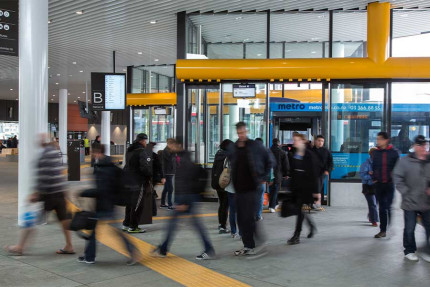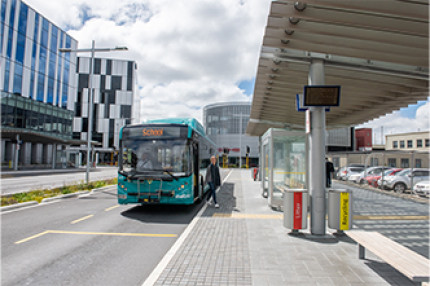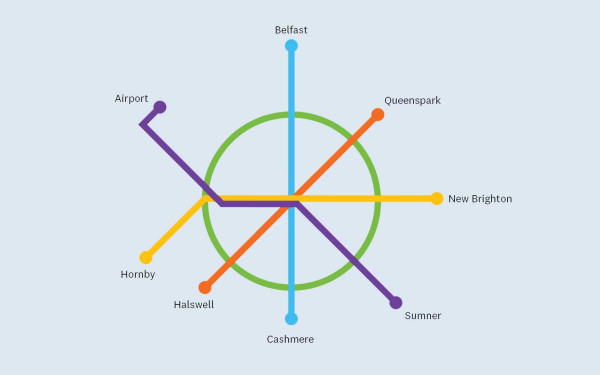Transforming public transport
As our urban areas grow, we are planning for better, more consistent public transport. Improved reliability, increased frequencies, and more extensive coverage. This will provide opportunities for more of us to use public transport as a smarter, more sustainable means of getting around.
Some of this work has already been completed, and patronage is increasing. Already, over 12.5 million passenger trips were taken on our network in 2023, and we are on track to carry 14 million trips in the 2024/25 financial year. This year, the number of people using public transport has grown from 18% of the population to 24% as a result of a range of improvements, including our flat fare trial.
At the same time, we've actively listened to the community's repeated calls for improved reliability, increased frequency, and broader coverage.
Delivering these changes over the next seven years, as proposed in our Long-Term Plan will provide service improvements more quickly and fast-track the many benefits of patronage growth.
About the Public Transport Futures programme
In 2020, we committed to improving public transport. Some of this is happening already, and some will take more time, depending on the funding we receive.
This investment programme, managed by a partnership which includes us, is called Public Transport Futures (PT Futures). It brings together public transportation services and the infrastructure that helps them function smoothly.
It’s all about improving our entire public transport network, beyond the bus services themselves. It includes repurposing road space for bus lanes and prioritising buses at intersections to improve journey times and reliability.
Our goals and commitment

More buses more often
Frequency improvements to the core routes lay the foundation for further expansion in the future.
These improvements make public transport more accessible and convenient, with high-quality, zero-emission vehicles and facilities.

Increasing patronage
We are aiming to grow from 12.5 million trips a year in 2023, to 17.4 million in 2027, and 20 million by 2030.
This would demonstrate a return to patronage levels similar to those of pre-earthquake Christchurch.

Upgraded bus shelters
Traveller information will be more readily available at upgraded bus shelters, which will also provide better protection from adverse weather.
These upgrades are delivered by our partner agencies under the PT Futures plan.
Programme funding
Looking ahead a full decade is no easy task. But it’s what we need to do under our 10-year work programme and budget – what we call our Long-Term Plan.
Public transport is often the biggest ticket item in our budget. We are committed to doing more to reduce emissions and traffic congestion, provide choice and unlock other environmental, economic, and social benefits with public transport.
The funding of public transport is a collaborative effort between NZ Transport Agency Waka Kotahi, the district and city councils (who fund the infrastructure) and Environment Canterbury. Public transport users also contribute through the payment of fares.
Planned service improvements
PT Futures is an investment programme that will provide more high-frequency services, revamped routes, and new connections, all aimed at enhancing your journey by reducing travel times and increasing reliability.
The PT Futures Plan has been developed by the Greater Christchurch Partnership, a coalition of local government, mana whenua and government agencies working collaboratively for better public transport.
Our focus is on breaking down barriers, providing easier access to growth areas and destinations, with the added perks of reduced congestion, improved air quality, and increased overall accessibility.
We’re firstly making improvements in the places where more people live. In these areas, buses will travel more frequently and have greater priority over other vehicles.
These planned improvements are subject to funding approval through the Long-Term Plan as well as the National Land Transport Plan which is administered by NZTA Waka Kotahi.
Consultation on our Long-Term Plan took place in March and April 2024. The final Long-Term Plan 2024-2034 is now being drafted for adoption by our Council in June. It will come into effect on 1 July 2024.
Specific enhancements
Increasing frequency, enhancing bus priority tools, employing advanced technologies, upgrading bus stops, and catering to cyclists and park 'n ride users are additional strategies for enhancing public transport accessibility and efficiency. Learn more about each enhancement.
Increased frequency
This programme introduces Turn Up and Go schedules, which provide the ultimate convenience by ensuring that buses arrive at intervals of just 10 minutes. Learn more about Turn Up and Go.
Bus priority
Bus priority tools are an important part of our plans to transform Christchurch’s public transport experience. There are two ways we can ensure buses have priority:
- Bus-only lanes: All day or in peak times only.
- Bus priority at traffic signals: Integrated with the onboard real-time information system to prioritise the bus if it is behind schedule.
Bus priority benefits:
- More reliable journey times for services
- More competitive travel times between bus and car journeys
- Improved reliability through kerbside bus lanes with safe boarding and alighting
- Improved reliability of services through bus priority measures such as intersection signal priority to buses and Traffic signal phasing for buses
These bus priority measures will be provided on the five core routes in the central city as well as in urban housing and employment centres, with changes to the roading network taking place as higher frequencies are introduced.
The Halswell Road and Lincoln Road bus lane projects demonstrate how these improvements will avoid delays and make it safer and more enjoyable to travel.
Greater use of technology
Smart use of technology makes it much easier to use public transport.
Recently, we have invested in cellular-based satellite-fed data. This upgrade already means that bus arrival times are more accurate, and customers enjoy advanced journey planning tools. You can easily see exactly how far away your bus is.
We have also added real-time information displays at key bus stops. These displays are easy to use, with no need to own a smartphone or other technology to use them. Likewise, the introduction of unique QR codes at every bus stop has eliminated the need to guess when your next bus will arrive. Scanning the QR code with your smartphone directs you to the Next Bus webpage specific to that particular stop.
Next, we will increase our use of this technology to enable bus priority at signalised intersections along the frequent routes. It also sends information to drivers so they can avoid ‘bus bunching’, where buses catch each other up.
Bus stop enhancements
Bus shelters make all the difference on a hot and windy or wet and rainy Canterbury day. The Public Transport Futures programme is improving the quality and comfort of bus shelters, using appropriate facilities depending on where the bus stop is located.
Connection stops
Bus stops at key destinations and activity centres on high-frequency core and orbital routes will include:
- real-time information
- all-weather shelters
- lighting and planting.
Key stops:
Bus stops in place on the less busy core and orbital routes will include:
- real-time information
- all-weather shelters
- lighting and planting.
Minor stops:
On all other routes, bus stops will have:
- printed timetable information
- standard bus shelter.
Multimodal infrastructure
Sometimes, it can be helpful to use a bike, electric scooter, car, or another bus to get to your bus service, especially if you live further away.
By providing useful services, we can make it easier to build the bus into your journey. We’ll be improving our facilities, including:
- cycle infrastructure and storage
- bike racks on buses
- e-mobility stands
- park ‘n ride.
We’ll also be investigating using on-demand bus services, similar to our trial in Timaru.
Programmes underway
The first stage of Public Transport Futures is already underway thanks to funding in our last Long-Term Plan, providing high-frequency public transport, reducing wait times and improving our management systems to regulate the intervals between buses and minimise buses bunching together.
Turn Up and Go
This programme aims to enhance the customer experience with a hassle-free Turn Up and Go approach on core routes. Turn Up and Go services will be provided from Monday – Friday between 7am-7pm.
Under Turn Up and Go frequencies, passengers no longer need to rely on checking timetables for their next bus.
Turn Up and Go revolutionises convenience by ensuring that buses arrive at intervals of just 10 minutes, translating to an average wait time of five minutes for customers. Outside of the hours of 7am-7pm, these services will run every 15 minutes.
High-frequency schedules are now in place for our three most popular routes:
- Route O Orbiter : every ten minutes all week and every 15 minutes in the evening and weekends
- Route 3 Airport – City - Sumner : every ten minutes all week and every 15 minutes in the evening and weekends
Our new Route 8 Airport – City - Lyttelton now runs every 15 minutes all week and every 20-30 minutes in the evening and on weekends. Increased frequencies are proposed on Route 8 under the draft Long-Term Plan.
Proposed Turn Up and Go networks
In the upcoming years, we plan to expand this service to additional routes to further improve accessibility and efficiency.
The following core routes will be improved (or moved) to Turn Up and Go frequencies (subject to funding):
- 2024/2025- Route 7 (Halswell to Queenspark)
- 2025/26- Route 1 (Rangiora to Cashmere) and Route 5 (Rolleston to New Brighton)
Express services and double-decker bus trial
We have also recently introduced:
- Lincoln and Waimakariri Express services to ensure a fast trip to and from the city for these residents that commute to Christchurch for work
- A trial of a double-decker Darfield service, which is a first for the Canterbury network.
Enhanced frequencies are proposed on existing city-bound services from Lincoln, Rolleston, Rangiora, and Kaiapoi in 2026/27.
Medium-term options
We're expanding travel options between city centres and outer suburbs, with more frequent connections and improved weekend schedules. The programme also enhances cross-city connectivity throughout the day and at weekends.
- A review of the connector and local services is scheduled for completion by 2025, to identify network improvements for implementation by 2031. Subject to funding, this review will be completed through a business case process, exploring service improvements outside of the core network. This is called the Rest of Network business case.
- Targeted improvements or “quick wins” that respond to demands on the public transport network including route changes and increased bus frequency are also planned, subject to Long-Term Plan funding.
Longer-term options
We are also exploring longer-term options, including the use of mass rapid transit. Read on below for information about these plans.
Greater Christchurch Partnership and Mass Rapid Transit
PT Futures is managed under Greater Christchurch Partnership, a coalition of local government, mana whenua and government agencies working collaboratively to address strategic challenges and opportunities for Greater Christchurch.
This group is also looking further out, at the changes we will need in the future, and exploring the creation of a Turn Up and Go public transport service using either light rail or larger, long buses. This would be a high-tech, high-frequency, high-capacity, no-emission public transport option.
Further information on the Greater Christchurch Partnership and Mass Rapid Transit.
Further information
Related consultations and transport plans
- The Regional Land Transport programme confirms our broader, regional priorities for land transport planning. It describes the region’s land transport system and the challenges it faces now and in the future. It sets out a vision and priorities for Canterbury’s transport network for the next 10 years, and how they might be achieved.
- The Regional Public Transport Plan will confirm our vision and longer-term aspiration for public transport. We will be consulting on this plan in August 2024.

